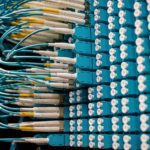In the age of the digital nomad, securing the fort while your team is scattered across the globe has never been more crucial. You've likely heard the basics—don't use "password" as your password and change it more often than you do your toothbrush. But as cyber threats evolve, so must our defenses. From establishing ironclad work-from-home policies to adopting a zero-trust architecture, these seven strategies are your arsenal against the unseen enemy. Implementing multi-factor authentication (MFA) and promoting cybersecurity awareness are just the tip of the iceberg. As you navigate this terrain, remember, it's not just about keeping the bad guys out; it's about ensuring that every virtual door and window is bolted, without making your home a prison. So, why should you care about layering your security or tracking every asset like it's the crown jewels? Let's explore the less trodden paths that could make or break your remote work security.
Key Takeaways
- Comprehensive policies, access control, and authentication systems are essential for ensuring remote work security.
- Multifactor authentication and identity verification should be emphasized to protect against evolving threats.
- Network security measures, including Zero Trust Architecture and secure cloud services, are crucial for a secure remote work environment.
- Cybersecurity awareness, best practices, and regular updates are necessary to mitigate vulnerabilities and secure remote work devices.
Formulate Comprehensive Policies
To effectively mitigate security risks in a remote work environment, it's essential to craft comprehensive policies that clearly delineate the boundaries for equipment and system usage. Establishing policies not only serves as a foundational step in securing remote work but also in guiding remote employees through the do's and don'ts of working from home. When you formulate these security policies, you're not just creating rules; you're building a framework that supports secure remote work.
Your approach should be multifaceted. Start by defining the permitted use of equipment and systems. This clarity ensures that remote employees understand their responsibilities and the limitations of their actions. Next, focus on employee education and monitoring. It's not enough to have security policies in place; you must also ensure that your team is fully aware of these protocols and adheres to them. Implementing comprehensive education programs on remote work security and conducting regular monitoring can drastically reduce security risks.
Moreover, managing access privileges through well-established policies is crucial. By controlling who has access to what, you minimize the potential for unauthorized access to sensitive company data. Lastly, don't overlook the importance of network security. Establish robust security measures to safeguard your remote workforce against cyber threats, ensuring a truly secure remote work environment.
Enhance Identity Verification
Enhancing identity verification processes is a critical strategy for securing remote work environments, ensuring that only authorized users gain access to sensitive company resources. As remote workers become increasingly prevalent, the necessity to enhance identity verification can't be overstated. It's not just about having strong passwords anymore; it's about layering security features to safeguard against evolving security threats.
To effectively enhance identity verification, consider implementing the following strategies:
- Implement biometric authentication:
- *For added security*, leverage fingerprint or facial recognition technologies.
- Utilize secure token-based authentication systems:
- Ensure tokens are regularly refreshed to maintain security integrity.
- Apply continuous verification:
- *For robust verification*, scrutinize identities more than once during a session.
- Emphasize the importance of multifactor authentication (MFA) for remote access.
Adopt Zero Trust Architecture
Adopting a Zero Trust architecture fundamentally shifts how we safeguard sensitive data and systems in a remote work environment, prioritizing continuous verification and minimal access principles to enhance security. By implementing a zero-trust access posture, you're not just adding a layer of security; you're redefining remote security paradigms to adapt to the increasingly sophisticated cyber threats targeting remote employees.
Incorporating privacy by design principles, Zero Trust architecture ensures that securing sensitive information doesn't come at the expense of user privacy. It's a strategic move towards maintaining a balance between security and privacy, vital in a remote work setting where the boundaries between professional and personal data can blur.
Focusing on maintaining user privacy, Zero Trust architecture demands that every access request, regardless of origin or destination, is continuously verified. This approach, coupled with multifactor authentication, significantly minimizes the risk of unauthorized access to sensitive information, thus securing the remote work environment more effectively.
Implement Multi-Factor Authentication
Building on the Zero Trust architecture's foundation, implementing multi-factor authentication (MFA) is a crucial step in fortifying your remote work security by requiring users to present multiple proofs of identity. This approach doesn't just add an extra layer of authentication; it significantly enhances the security of your company's sensitive information and systems, especially as your employees work remotely.
When you integrate MFA, you're not just improving access control; you're strengthening the security framework for remote work. Here are a few security tips to make MFA more effective and relatable:
- Choose the Right MFA Tools:
- Consider software that supports a wide range of devices, including remote devices and those using personal networks.
- Opt for MFA solutions that offer flexibility without compromising on security.
- Educate Your Team:
- Provide clear instructions and training on how to use MFA tools.
- Share best practices and the importance of MFA in adding extra security to their daily operations.
Develop a Layered Defense Strategy
To fortify your organization's cybersecurity posture, it's essential to develop a layered defense strategy that incorporates multiple technologies and principles for robust protection. In the realm of remote work, where the boundaries of the traditional office network are blurred, deploying a multifaceted defensive framework becomes even more critical.
Firstly, require employees to connect to the company network through a virtual private network (VPN). This ensures that all data transmitted between their home and the office is encrypted and secure, forming a vital layer of defense. Additionally, integrating secure cloud services for storage and collaboration can safeguard sensitive information outside the traditional network perimeter.
Incorporating managed detection and response tools alongside multifactor authentication and zero-trust security measures adds depth to your security strategy. These layers work collectively to monitor for threats in real-time, verify identities meticulously, and ensure that trust is never assumed within or outside the network.
Segmentation of network resources further enhances security by limiting access to critical assets, thus minimizing the potential impact of a breach. Coupled with regular updates, patching of all software, strong endpoint security measures including antivirus software, and comprehensive data encryption, your organization can achieve a robust, layered defense strategy that significantly mitigates the risk of cyber threats in a remote working environment.
Utilize Secure Cloud Services
Leveraging secure cloud services enables you to store and manage sensitive data remotely with enhanced security measures. In the wake of the COVID-19 pandemic, the shift to remote work has underscored the critical importance of adopting BEST PRACTICES for cloud security. Here's how:
- Implement strong encryption protocols to ensure that your work-related data remains confidential and secure from unauthorized access.
- Regularly update and patch cloud services to mitigate vulnerabilities, keeping operating systems and work devices secure against emerging threats.
To make your remote work security strategy robust, consider the following:
- Utilize cloud-based access controls and permissions**:
- For granular management of user access.
- To enforce multifactor authentication, adding an extra layer of security.
- Leverage cloud-based backup and recovery systems**:
- To prevent data loss.
- Ensure business continuity with minimal downtime.
It's essential to extend these practices to all mobile devices and employ device management software for comprehensive device management. As the landscape of remote work continues to evolve, staying informed and proactive in utilizing secure cloud services will safeguard your sensitive information against potential cyber threats.
Promote Cybersecurity Awareness
Raising cybersecurity awareness among employees is a crucial step in fortifying your remote work environment against digital threats. As you've transitioned to working remotely, it's imperative to make sure that everyone understands their role in maintaining security. By conducting regular training sessions, you can highlight potential risks like phishing scams and video attacks, and how to mitigate them.
Creating a security-conscious culture within your organization encourages employees to take responsibility for their cybersecurity. This involves not just a one-time training but providing ongoing education to keep everyone up-to-date with the latest threats and best practices. It's essential to empower your team to be vigilant and cautious, especially when using personal devices for work.
Including multifactor authentication and educating on the importance of setting strong passwords are foundational steps. Encourage your employees to create strong, unique passwords for different accounts to help protect sensitive information. Moreover, emphasizing the significance of securing their home network serves as a crucial line of defense in safeguarding the company's data. By promoting cybersecurity awareness, you're equipping your team with the knowledge they need to act as the first line of defense against cyber threats.
Frequently Asked Questions
How Can Remote Working Be Made More Secure?
To make remote work more secure, you should establish strong WFH policies, secure your identity perimeter, leverage zero trust, implement MFA, and build layered security. These steps significantly enhance protection against potential threats and breaches.
What Are Important Ways to Ensure Digital Security While Working Remotely?
Ironically, to ensure digital security while working remotely, you'd think it's all about tech. But it's also about you embracing MFA, understanding zero-trust principles, and staying disciplined with secure web practices and VPNs.
What Are the Key Security Concerns When Working Remotely?
You're facing key concerns like insecure network connections, lax work-from-home policies, weak authentication methods, insufficient employee training on security practices, and unsecured identity management while working remotely. Addressing these can significantly boost your security posture.
What Are the 3 Prescribed Steps to Achieve a More Secure Remote Workforce?
To achieve a more secure remote workforce, you'll need to establish comprehensive WFH policies, implement multi-factor authentication (MFA), and leverage zero trust. These steps ensure your team's safety and protect sensitive information effectively.






